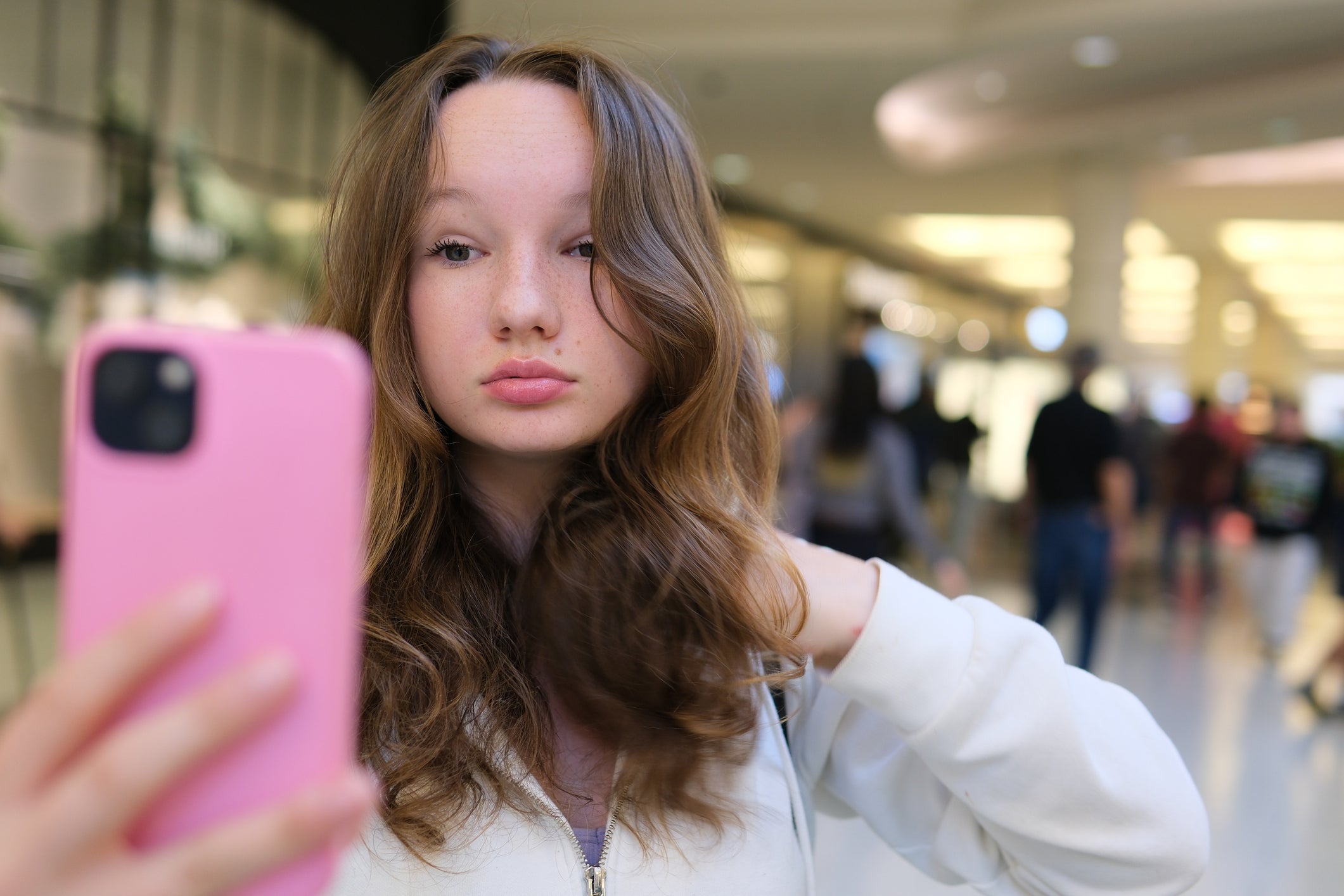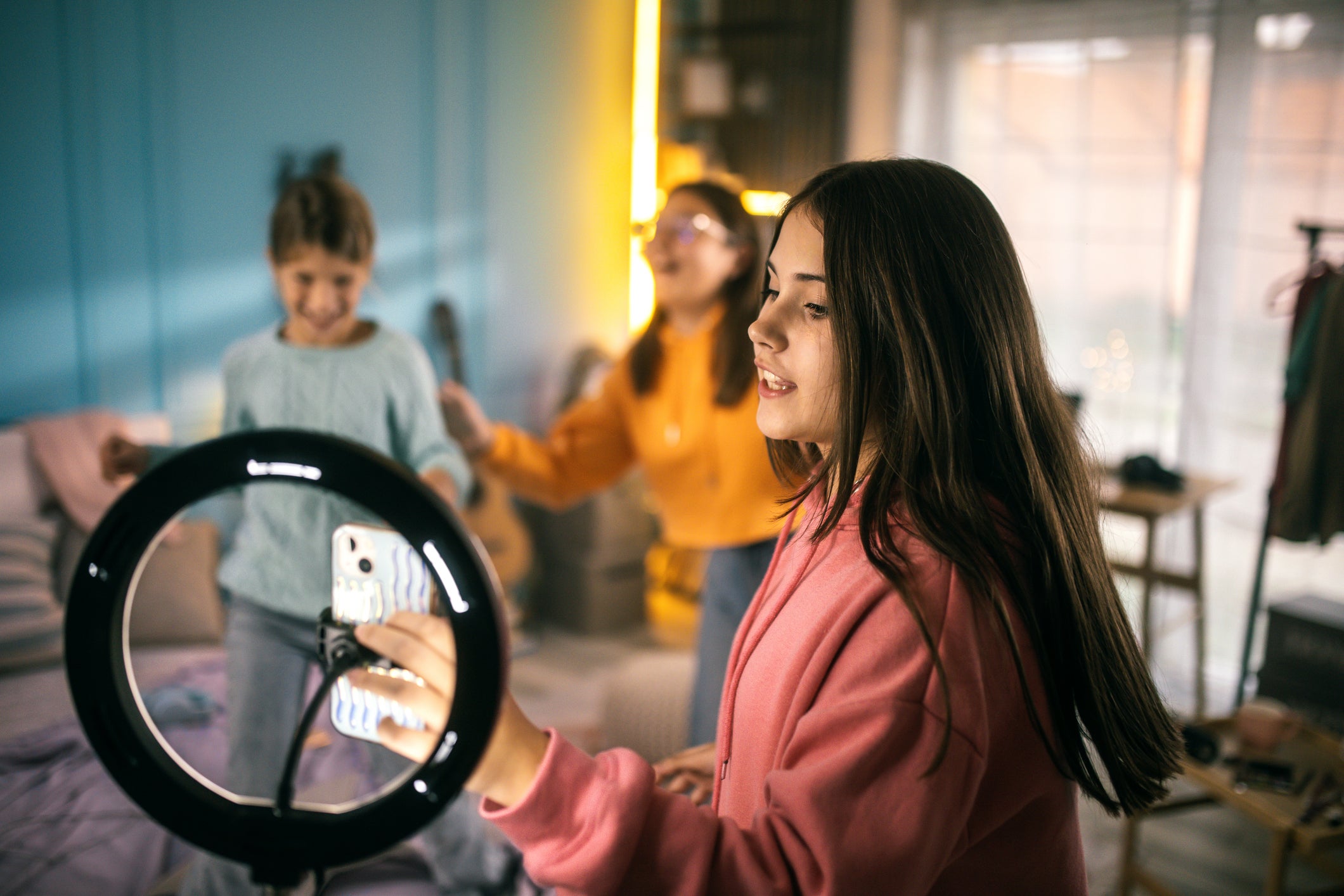Aged 13, I became obsessed with taking selfies. I would pout and post and watch the likes roll in. Rinse and repeat. Except what I was capturing on my phone’s camera wasn’t actually me – it was a beautified version of my face that wasn’t real. The person on my screen bore a resemblance to me, but everything was polished to perfection. She had a narrower face, a smaller nose, smoother skin, plump lips and enlarged Pixar princess-style eyes. I was enamoured with the results. Every picture I posted would be that unattainable version of my face.
I had become hooked on using beauty filters: an AI-powered digital tool that can enhance a person’s appearance in real time. Apply one of these filters and you’ll look like Kim Kardashian’s sixth sister, a Victoria’s Secret model or someone who has undergone a series of drastic tweakments, since the filters are often designed to cater to current hegemonic standards of beauty.
When I was a teenager in 2013, these filters were available in their early forms on Instagram and Snapchat, since TikTok wasn’t yet invented. Even though the filters I used back then were relatively crude compared to today’s offerings, they still consumed my life – and my self-perception.
That’s why I’m pleased to hear that TikTok will soon restrict the beauty filters that can be accessed by teenage users. In the coming weeks, under-18s will be blocked from artificially making their eyes bigger, plumping their lips and smoothing their skin texture through the use of filters, as a result of concerns about rising anxiety and falling self-esteem among younger generations. The restrictions will apply to the more drastic filters, not the fun ones that add bunny ears or dog noses. Among the restricted filters are the popular “Bold Glamour” filter, which bronzes the skin tone, gives your eyebrow a high arch, chisels your jawline and makes your lips thicker. This is surely good news. But will the ban go far enough? Or has the very existence of AI beauty filters created an untameable beast?
Smartphone filters date back to the early 2010s; the iPhone 4 was Apple’s first product with a selfie camera. If you’ll allow me to recap the dark ages of social media, then you may remember the first version of Instagram after it launched in 2010, which included the filters “Sierra” and “Mayfair”. These were relatively harmless photo effects, which changed the colour and texture of the overall picture. They weren’t intended to beautify the subjects in the photo, while the filter could only be applied after the picture was taken.
That all changed in 2011, when the Instagram 2.0 update introduced “live filters” which allowed users to apply their effects while they were taking the actual picture. Filters became so popular that in 2013 the hashtag #NoFilter became a catch-all phrase to signify absolutely no digital alteration had taken place. By 2015, chatroom app Snapchat released its “lenses” feature, which introduced facial recognition technology into filters. Initially, it started with fun, child-friendly filters – you could vomit a rainbow when you opened your mouth, for example. After that, though, things got less fun, more advanced, and filters became geared towards perfecting one’s features.
Today, people can design their own filters and use them on a range of social media platforms. For example, in 2020, the “Perfect Skin” filter for Snapchat and Instagram – created by Brazilian augmented reality developer Brenno Faustino – gained millions of impressions in the first 24 hours of its release. You can use filters like these to record yourself in real time, which means you can wear the filter as you talk, move your face, or even look in different directions. This level of advancement makes a particular look feel attainable and realistic. And swathes of young people have reported seeing their real faces as ugly once they’ve used facial filters.
Dr Lisa Strohman is a clinical psychologist and author of Unplug: Raising Kids in a Technology Addicted World. She tells me that she’s seen first hand how filters can give the children who use them a false sense of reality. “Continual exposure to altered images can shape teens’ beliefs about what they should look like, leading to them valuing their filtered selves over their real selves,” she explains. “Filters decimate the self-esteem and self-worth of children.” For the young, whose brains are constantly developing – along with how they perceive themselves – filters are especially damaging because they promote a standard of beauty that’s only achievable after spending thousands on plastic surgery or injectables.
It’s interesting, then, to consider that the word filter also describes something that can sift out unwanted impurities. A facial filter essentially does the same – by removing what we dislike about our faces. Biopsychologist Dr Mary Poffenroth tells me that young people can become more accepting of the faux face they see before them over their own. “When people see filtered faces on a regular basis, the brain starts to accept this as the norm,” she explains, adding that this can result in a neurological disconnect. “This gives a distorted view of one’s own appearance, and the person may find it more difficult to accept their true features.”

And then there’s the “likes”. They’ve long meant instant gratification, but they can fuel an addictive cycle, says Poffenroth. She describes the slow build-up of likes on a selfie as a “reward system in the brain” that can trigger the release of dopamine. “As a result, people may find it more difficult to resist the temptation to constantly alter and improve their appearance, even when they are aware of the possible negative consequences,” she says.
When the possibilities of how we could look become presented to us, it’s no wonder that cosmetic treatments like lip filler and Botox are on the rise among women as young as 18. Plastic surgeon Steven Hanna tells me that he’s constantly navigating the balance between aesthetic trends, patient expectations and surgical safety. In a recent paper he authored for Oxford’s Aesthetic Surgery Journal, he examined how cosmetic practitioners have a growing responsibility to manage patients’ expectations and educate them on the cyclical nature of social media trends, before making the decision to go under the knife or needle.
“Filters portray unattainable results that cannot be achieved surgically, or may require risky, multi-step interventions,” Hanna explains. He’s noticed how social media trends leave people dissatisfied with their own appearance and, believe it or not, this is not a desirable circumstance for a surgeon. “I frequently talk to my patients about focusing on safe, achievable goals, steering them away from unrealistic expectations influenced by filters … we need to continue educating adolescents about body positivity and critical thinking around media imagery.”

Strohman says that the TikTok facial filter ban is a welcome change – but it’s not enough. As adults, we need to teach children that what they see on social media isn’t always real. “TikTok’s decision is a step forward, but we must also continue to educate and empower young people to navigate these platforms in a way that prioritises their wellbeing,” she says. “Encouraging authenticity, fostering media literacy, and promoting healthy body image are key to mitigating the harmful effects of AI-generated beauty filters.” Authenticity is a word I find interesting, here, since social media lacks it totally. I would know, because I spent several years trying to alter my appearance online.
Social media sites do little to tell us the truth about the images we view. Hanna says that platforms like TikTok could start adding disclaimers to altered images that might remind users that the filters are artificial, and that they’re not reflective of a humanly possible appearance. This is something that Instagram is rumoured to be introducing in an attempt to deter people from uploading edited Photoshopped pictures, but nothing has been put in place so far.
I’m pleased to say that I eventually grew out of using facial filters. But perhaps I was just lucky that the filters I used as a teen were less advanced. On a mission to see what is available today, I scroll through TikTok’s current offerings – one filter gives me false fluttery eyelashes, another chisels my jawline to look like I’ve undergone buccal fat removal, and another gives me realistic freckles and a cute, pointy nose. It’s tempting. But it’s not real. I just hope young children will get the message.







